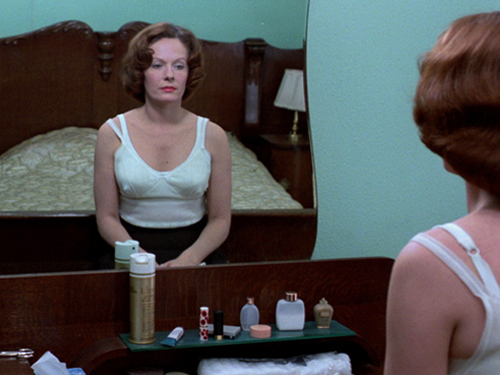Chantal Akerman
Traversing the Land of Cinema

“The way I would like to film corresponds to the idea that the land one possesses is always a sign of barbarism and blood, while the land one traverses without taking it reminds us of a book.”
- Chantal Akerman
Chantal Akerman (1950-2015) was a pioneering Belgian film director, screenwriter, producer, artist, and writer whose career spanned four decades. Born in Brussels to a Jewish family, Akerman’s early exposure to cinema began with Jean-Luc Godard’s Pierrot le fou (1965), which inspired her to take up filmmaking at the Brussels film school INSAS. However, she left the rigid confines of film school prematurely to pursue her own approach to filmmaking. She made her debut in 1968 with the short film Saute ma ville, in which the then eighteen-year-old Akerman shuts herself away in her apartment and goes about her business in a strangely manic way. After leaving INSAS, Akerman moved to New York, where she encountered the experimental cinema of Jonas Mekas, Michael Snow, and Andy Warhol. Their work would have a great impact on her filmmaking. The films she created during her time there include La chambre (1972) and Hôtel Monterey (1973).
Upon her return to Belgium, she directed Je, tu, il, elle (1974) and then raised the necessary funds to produce Jeanne Dielman, 23, quai du Commerce, 1080 Bruxelles (1975). Jeanne Dielman documents three days in the life of a widow, played by the iconic French actress Delphine Seyrig. For more than three hours the camera follows in minute detail as she tidies the apartment, peels the potatoes, prepares dinner, polishes her son’s shoes, goes shopping, and prostitutes herself every afternoon. The repetitive rituals of her daily routine, and the long and static shots create a simultaneous sense of intimacy and discomfort, turning the viewer into an active participant in the unfolding, small narrative. These studies of domestic and relational dramas and scenes often return in Akerman’s work. In 2022, the once-a-decade Sight and Sound poll voted Jeanne Dielman the greatest film of all-time.
Akerman made a total of more than 40 films, including Les rendez-vous d’Anna (1978), Toute une nuit (1982), Le captive (2000), La folie Almayer (2011), and the documentary trilogy DʼEst (1993), Sud (1999), and De lʼautre côté (2002). Akerman’s work is defined by a great creative freedom as it wanders between genres, between experimental and classical cinema, between fiction and documentary, musical comedy and literary adaptation. For example, Chantal Akerman also tried her hand at the musical with Golden Eighties (1986), a tragicomic musical comedy set in the Galerie de la Toison d’Or in Brussels.
Her oeuvre extends beyond her filmography into installation art and writing. In 1995, she created a large spatial installation on 25 monitors based on D’Est (1993), a film originally made as a documentary, marking the start of her “second career” within the world of visual art. She reconfigured more of her documentary and fictional works, like Sud (1999), De lʼautre côté (2002), Là-bas (2006), Tombée de nuit sur Shanghai (2009), and La chambre (2012) into installations. Chantal Akerman’s writing was also met with great acclaim. Her most renowned written work, My Mother Laughs (2013), is a collection of reflections written in between caring for her dying mother.
This collection provides an overview of the available English-language texts on Sabzian on the work of Chantal Akerman as well as a complete multilingual annotated filmography.1 2
- 1Image from Collections CINEMATEK & Chantal Akerman Foundation / © Jane Stein
- 2In collaboration with the Chantal Akerman Foundation



















































